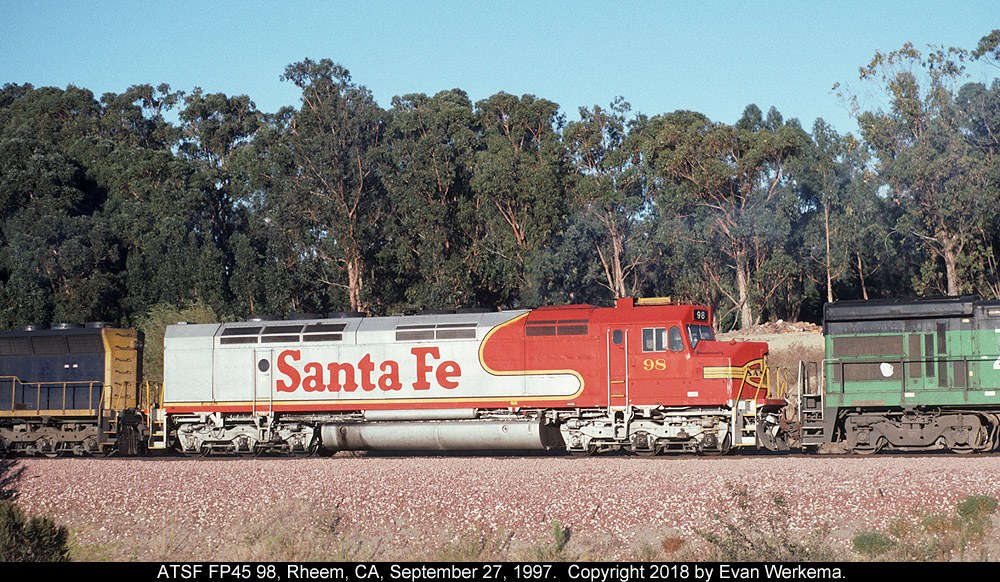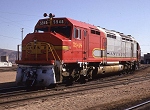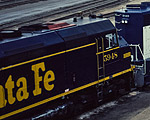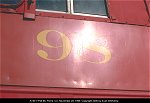ATSF FP45 98 |
|---|
 |
ATSF FP45 98 |
|---|
 |
History | |
|---|---|
 |
Santa Fe FP45 98 was built as Santa Fe 108 in December 1967, the last of 9 FP45's acquired by the railroad. It was renumbered 5948 in March 1970 as part of the 1969/70 general renumbering. When E.D. Motis caught the unit at Barstow, CA on March 21, 1970, she still had over a year of passenger service ahead of her before the coming of Amtrak. The FP45's were delivered with 3-chime Leslie S-3L airhorns such as the one in the photo, but were eventually fitted with the 5-chime S-5T, Santa Fe's standard passenger horn. |
 |
The FP45's were reassigned to freight duties full-time after Amtrak took over passenger service on Santa Fe's lines in 1971. In late 1971 or early 1972, 5948 traded its passenger paint for the blue with yellow details freight scheme and its steam generator was removed. Other legacies of its passenger career took longer to vanish. The top view at left by E.D. Motis shows the unit at Barstow, CA on May 20, 1972, with her passenger S-5T airhorn and gyralight intact, and traces of passenger silver already starting to show through on the fuel tank and pilot. Ten months later the 5948 was in Barstow again, and Bob Finan recorded her standing outside the diesel shop in the lower view. The passenger 5-chime has given way to a 3-chime S-3L once again and an amber beacon has been added. |
 | |
 | By January 1974, all of Santa Fe's FP45's had been repainted into the new blue and yellow warbonnet scheme except for the 5948, which kept its pinstripe paint long enough to lock knuckles with one of Santa Fe's bicentennial-painted SD45-2's. Jim Bartolotta caught it at Bakersfield, CA in April 1976 coupled to red-white-and-blue 5703. Interestingly, the 5948 also appears to have a red dust-blower hatch on the roof, presumably transplanted some years before from an FP45 that was still in the red and silver passenger scheme. |
 | |
 | The 5948 was finally repainted into the blue and yellow warbonnet scheme in January 1977. When Jim Spears photographed the unit in 1980, it looked the part of a general freight locomotive, but still had the gyralight between the numberboards and the ATS shoe bracket on the front journal as evidence of its passenger-hauling past. In August 1982, the 5948 was rebuilt at the Santa Fe shops in San Bernardino, CA, emerging as the 5998. |
 |
In mid-1986, 5998 was painted in the short-lived red and yellow SPSF warbonnet scheme in anticipation of the Southern Pacific Santa Fe merger. Tom Jones photographed the unit shortly thereafter as it lead a two car special at Los Angeles, CA. Note the Automatic Train Stop (ATS) shoe hanging from the first journal of the lead truck. In the lower photo, Bob Finan caught 5998 leading another special westbound at Helendale, CA on April 12, 1986. This train was run to commemorate Santa Fe's century of service between Barstow and Los Angeles, and was authorized for 79 mph. An Amtrak F40PH tagged along to provide HEP for the borrowed Superliners. An ex-ATSF hi-level transition coach and two single level Santa Fe business cars brought up the rear. The FP45's were delivered with a 57:20 gear ratio for passenger service, and were regeared to a still speedy 59:18 ratio during their first decade as freight units. Some retained ATS equipment for use on specials such as these. In the late 80's, the units were regeared again to a more typical freight gear ratio of 62:15. |
 | |
 |
The 5998 seemed to get more than its share of calls for special duty, but in between passenger specials, it was just another freight unit. Around the time of the merger denial in July 1986, John Sjolander found it leading a C30-7 and an SDF40-2 (ex-Amtrak SDP40F) at Emporia, KS. |
 |
By the time the SPSF merger was denied by the ICC in July 1986, all but one of the FP45's had been painted in red and yellow. Santa Fe soon had several FP45's back in blue and yellow, with 5998 among the first to be painted in April 1987. John Hake caught it and two other blue and yellow FP45's leading the 1987 edition of the directors special. |
 |
Two years later, in February 1989, the unit was waiting for its next assignment at Albuquerque, NM, and looking rather dingy. This would soon change, however... |
 |
In July 1989, 5998 became one of the first two FP45's to be repainted in Superfleet red and silver and assigned a 100-class number. The FP45's were renumbered out of sequence when they went into the 100-class, and 5998 became the new 102. Nine months after the previous photo at Albuquerque, and four months after receiving its new look and identity, 102 leads 100, 101, and 104 at the Swarthout Canyon Rd. grade crossing near Cajon, CA on November 18, 1989. Photo by Gary Kluge. |
 |
Anticipating the arrival of the 100-class GP60M's, 102 was renumbered back to 5998 in May 1990, and a few weeks later was renumbered again to 98. The old 100-series number was still visible under the new paint if viewed from the proper angle. |
 |
The photos at left show the front and rear of 98 as it looked on July 5, 1991. The unit still has a red air conditioner box on the cab roof, a feature the red and silver FP45's gradually lost as the A/C units failed and were replaced with the more common yellow units. Note also that the 98 still has its original steeply sloping pilot. |
 | |
 |
Less than two months later, on August 31, 1991, Jim Bartolotta photographed the 98 sporting a new plow pilot leading a westbound between Cameron and Monolith, CA. The reason for the swap is unknown. A handful of F45's also lost their original pilots for plows, but 98 is the only FP45 known to have received this modification. |
 |
The red and silver warbonnet paint seemed to hold up better on 98 than on the other FP45's. In late September 1997, only months from retirement, the unit still looks great as it lends its muscle to an eastbound freight near Richmond, CA. |
 |
FP45 98 was taken out of service in late 1997, suffering from low oil pressure and low compression on three cylinders. In January 1998, the locomotive was donated to the Orange Empire Railway Museum (now the Southern California Railway Museum) at Perris, CA, arriving at the museum on March 19, 1998. The photo shows 98 as it appeared in November 1999 after a few "backdating" modifications: air conditioner removed, silver touched up, and a Gyralite with two clear lenses in the upper headlight position. Internally, the oil pump had been replaced, and the locomotive had been mechanically restored to full operating condition. |
 |
A full cosmetic restoration to as-delivered condition, including new side panels and a replacement pilot salvaged from F45 5989, commenced in 2012 and was completed in October 2018. The middle photo at left shows the engine soon after its unveiling, piloting one the museum's annual Pumpkin Patch Express trains in Perris. |
 | |
 | |
References |
|---|
| 1. EuDaly, Kevin, Santa Fe 1992 Annual, Denver: Hyrail Productions, 1992. |
| 2. Korn, Chris, OERM EMD Master Mechanic, private communications. |
| 3. McMillan, Joe, Santa Fe's Diesel Fleet, Chatham Publishing Co, 1975. |
| 4. McMillan, Joe, Santa Fe Motive Power, McMillan Publications, 1985. |
| 5. Shine, Joseph, Santa Fe 1987 Motive Power Review, Four Ways West Publishing, 1988. |
| Special thanks to Jim Bartolotta, Bob Finan, John Hake, Tom C. Jones, Gary Kluge, E.D. Motis, John Sjolander, and Jim Spears for the use of their images. |
Back to Santa Fe Preserved Locomotives